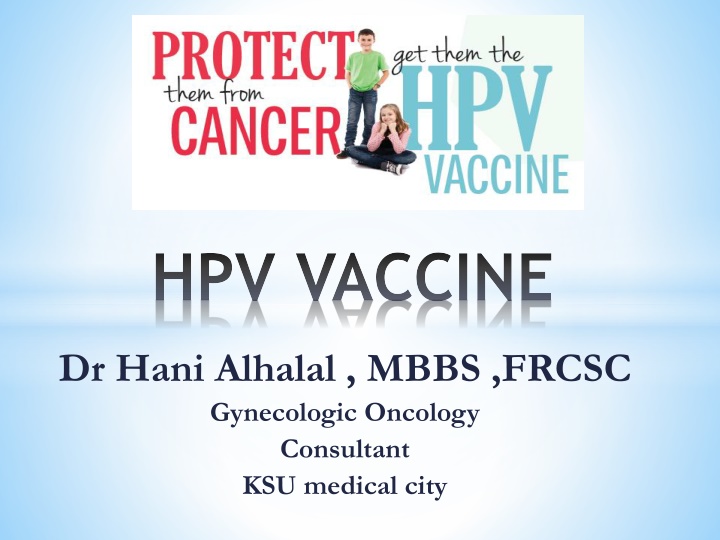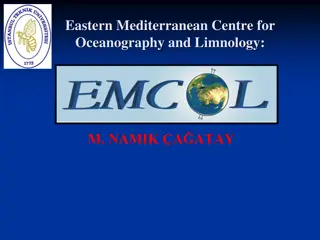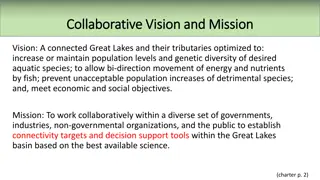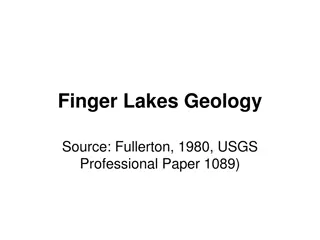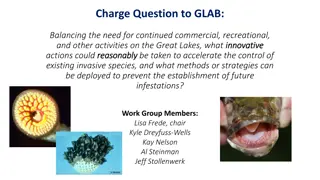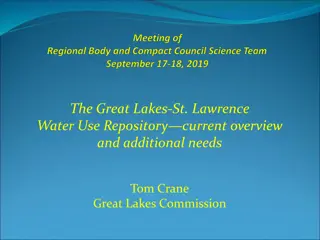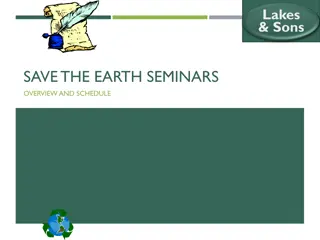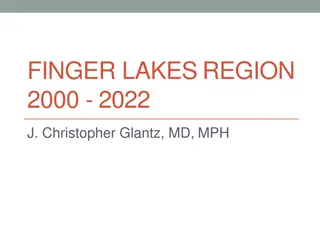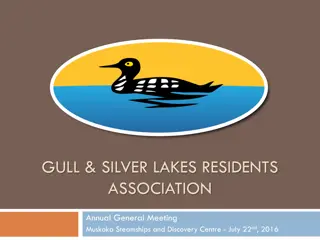Limnology: Science of Lakes - Historical Overview
Limnology, the study of inland aquatic ecosystems, has its roots in the early 20th century with Francois Alphonse Forel being considered the father of Limnology. The discipline encompasses the study of lakes and their ecological systems, independent of their origins or sizes. It involves various scientific fields such as Ecology, Botany, Zoology, Geology, and Chemistry. Thienemann's work highlighted the correlation between lake fauna and the surrounding geology. The classification of lakes based on physical, chemical, and biological characteristics further advanced the field. Understanding different regions or zones of a lake, such as the littoral, pelagic, and profundal zones, is crucial in studying lake ecosystems.
Download Presentation

Please find below an Image/Link to download the presentation.
The content on the website is provided AS IS for your information and personal use only. It may not be sold, licensed, or shared on other websites without obtaining consent from the author.If you encounter any issues during the download, it is possible that the publisher has removed the file from their server.
You are allowed to download the files provided on this website for personal or commercial use, subject to the condition that they are used lawfully. All files are the property of their respective owners.
The content on the website is provided AS IS for your information and personal use only. It may not be sold, licensed, or shared on other websites without obtaining consent from the author.
E N D
Presentation Transcript
HPV VACCINE Dr Hani Alhalal , MBBS ,FRCSC Gynecologic Oncology Consultant KSU medical city
1. WHAT IS HPV 2. HPV RELEATED INFECTIONS 3. PREVELANCE IN U.S AND SAUDI ARABIA 4. TYPES OF VACCINES AVILABLE 5. TIME OF VACCINATION 6. DOSES AND ADMINISTRATIONS 7. DURATION OF PROTECTION 8. SAFETY OF THE VACCINE
Human papillomavirus DNA virus from the papillomavirus family over 150 types are known More than 40 types are transmitted through sexual contact and infect the anus and genitals. spread by sustained direct skin-to-skin contact with vaginal and anal sex It does not spread via common items like toilet seats cannot be cultured without living tissue
DISEASE ASSOCIATIONS: HPV-related disease in females Cervical cancer and precursor lesions -is the third most common female cancer worldwide -IN U.S -THE ESTIMATED ANNUAL INCIDENCE OF CIN AMONG FEMALE is 0.5% -HPV TYPE 16 AND 18 : 70% of cervical cancer and 50 % of precancerous lesions -HPV types 31, 33, 45, 52, and 58 : 19 % of invasive cervical cancers
Genital warts HPV types 6 and 11: 90% of genital warts. Physical and psychological discomfort
1989 HPV VACCINE?
U.S FDA Approved ? 2006
Saudi Food and Drug Administration approved prophylactic HPV vaccine in 2010
Three different vaccines have been developed against HPV :
It is approved for the prevention of cervical cancer and cervical and vulvar intra epithelial neoplasia in young women approved for both men and women from the ages of 9 to 26 for the prevention of genital warts, anal cancers, and anal intraepithelial neoplasias. In October 2018, it was approved too for women at age 27-45 y.
Two large, randomized, double-blind, placebo- controlled trials have evaluated the efficacy of this vaccine in more than 17,000 adolescents and young females : 1. Among HPV-na ve populations, the efficacy for preventing CIN2 or more severe disease due to HPV types included in the vaccine, was 97 to 100 %
2.In the overall population of study participants (with or without prior HPV infection), the efficacy of for preventing CIN2, or more severe disease due to HPV types included in the vaccine was significantly lower at approximately 44 % after a mean follow-up period of 3 years. This reduction in efficacy reflects the fact that the vast majority of enrollees in this trial were already sexually active and many had been previously infected with vaccine HPV types The National Cancer Institute Reviewed: November 2, 2016
is approved In December 2014, the United States' Food and Drug Administration (FDA) for women and girls aged 9 to 26 and men and boys aged 9 to 15.
a 9-valent vaccine, targets the same HPV types as the quadri- valent vaccine (6, 11, 16, and 18) as well as types 31,33, 45, 52, and 58 . An international trial reported the efficacy of this vaccine in approximately 14,000 females aged 16 to 26 years who were randomly assigned to receive the vaccine : 1.Among HPV-na ve populations, the efficacy of 9-valent vaccine for preventing CIN2 or more severe disease, VIN2 or 3, and VaIN2 or 3 associated with HPV types 31, 33, 45, 52, and 58 was 97 % The National Cancer Institute Reviewed: November 2, 2016
-a bivalent vaccine, targets HPV types 16 and 18 -is approved for girls and women aged 9 to 25 for the prevention of cervical cancer and CIN.
One large randomized clinical trial in more than 18,000 young females aged 15 to 25 years demonstrated the efficacy of bivalent HPV vaccine . Among HPV-na ve patients, the efficacy of the vaccine for preventing CIN2 or more severe disease due to HPV types included in the vaccine was 93 %
In the overall population of study participants (with and without prior HPV infection), vaccine efficacy for preventing CIN2 or more severe disease due to HPV types included in the vaccine was significantly lower at 53 % after a mean follow-up period of approximately 3 years. * The National Cancer Institute Reviewed: November 2, 2016
American Cancer Society (ACS) guidelines should be routinely offered to 1.females aged 11 to 12 years; immunization may begin at 9 years of age . 2.catch-up vaccination for females aged 13 to 18 who have not been previously vaccinated or completed their vaccine series. 3.The ACS notes that there is insufficient evidence to recommend for or against vaccination of females aged 19 to 26 years.
IMMUNIZATION IN SPECIAL PATIENT POPULATIONS
What about ? Pregnant females?
According to CDC RECOMMENDATIONS not recommended given that safety in this setting has not been thoroughly evaluated . If a woman is found to be pregnant after initiating the vaccination series, the remainder of the three-dose regimen should be delayed until after completion of the pregnancy
In quadri valent HPV vaccine trials, the composite rate of adverse pregnancy outcome (spontaneous abortion, late fetal death, congenital anomaly) was similar for the 3819 females who became pregnant and controls who did not receive the vaccine (22.6 versus 23.1 percent) Similarly reassuring findings have been reported for the bivalent HPV vaccine and for the 9-valent HPV vaccine , although data are more limited Safe in lactating females as it dose not affect the infant breast feeding
Immunization in females with pre-existing cervical abnormalities or genital warts
A history of genital warts, abnormal cytology, or +VE HPV DNA test result is not evidence of prior infection with any or all of the vaccine HPV types vaccination can still provide protection against infection with HPV vaccine types not already acquired. assessment with Pap testing or screening for existing HPV infection is NOT indicated as part of the determination for HPV vaccine candidacy. these patients should be advised that vaccination will have no therapeutic effect on pre-existing HPV infection or CIN , and the potential benefit of HPV vaccination is not as great as if they were vaccinated before they started having sex.
Transplant recipients and HIV- infected patients
Studies of the HPV quadrivalent vaccine in HIV-infected adult men and women aged 16 to 23 years , boys and girls aged 7 to 12 years suggest that it is both immunogenic and safe in these populations. efficacy data are not yet available.
For solid organ transplant recipient It is safe to be given 3 to 6 months following trasplantation
VACCINE DOSE AND ADMINISTRATION According To CDC GUIDELINES ON DEC 2016 Immunization schedule In the United States, as of 2016, the recommended dosing schedule depends on the age of the patient Individuals younger than 15 years should receive two doses of HPV vaccine at least six months apart.
Individuals 15 years or older should receive three doses of HPV vaccine over a minimum of 24 weeks. The minimum interval between the first two doses is 4 weeks and the minimum interval between the second and third doses is 12 weeks. The Gardasil and Gardasil 9 are typically administered in three doses at time zero, and at two and six months of follow-up. Cervarix follow a similar three-dose schedule for those older than 15 years, the bivalent vaccine is typically administered in three doses at time zero, and at one and six months of follow-up.
Interrupted schedules if the vaccination series is interrupted for any length of time, it can be resumed without restarting the series.
For how long ? Duration of protection ?
IN ALL CLINICAL TRIALS Persistent antibody levels and protection against HPV infection have been reported up to 10 years following vaccination . Of note, the precise level of antibody needed for protection against infection is unknown. Further data will become available in the future as female and male participants in vaccine studies are followed over time. * CDC GUIDELINES DEC2016
Results: HPV-16 and -18 antibodies peaked at Month 7 and gradually plateaued at Months 18 24 and remained stable through 6.4 years Mean antibody levels at the last time point were several fold higher than those associated with natural infection. The study predict that HPV-16 and -18 mean antibody levels will remain well above those associated with natural infection for at least 20 years
All vaccines use virus-like particles (VLPs) which mimic the viral capsid. VLPs do not contain genetic material and are produced in biologic systems, which have well- established safety records
Among serious events, headache, nausea, vomiting, fatigue, dizziness, syncope, and generalized weakness were the most frequently reported. There is no increased risk of Guillain-Barr Syndrome compared with other vaccines in similar age groups Through 2011, 72 post-vaccination deaths had been reported, of which 34 were confirmed. There was no unusual pattern or clustering to the deaths that would suggest that they were caused by the vaccine
A small massage to take here is -HPV vaccination appears to be safe and effective in preventing subsequent infection in older women, but the overall benefit is less than that in younger females -the need to vaccinate individuals before the onset of sexual activity to gain the greatest benefit and maximize cost effectiveness.
-None of the three vaccines treats or accelerates the clearance of pre-existing vaccine-type HPV infections or related disease.
